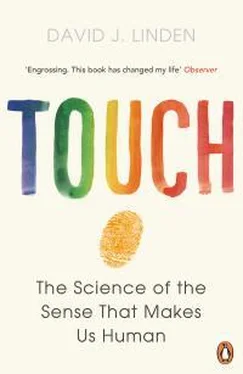15. I. Gordon, A. C. Voos, R. H. Bennett, D. Z. Bolling, K. A. Pelphrey, and M. D. Kaiser, “Brain mechanisms for processing affective touch,” Human Brain Mapping (2011), doi:10.1002/hbm.21480; F. McGlone, H. Olausson, J. A. Boyle, M. Jones-Gotman, C. Dancer, S. Guest, and G. Essick, “Touching and feeling: differences in pleasant touch processing between glabrous and hairy skin in humans,” European Journal of Neuroscience 35 (2012): 1782–88; and L. Lindgren, G. Westling, C. Brulin, S. Lehtipalo, M. Andersson, and L. Nyberg, “Pleasant human touch is represented in pregenual anterior cingulate cortex,” NeuroImage 59 (2012): 3427–32.
16. A. C. Voos, K. A. Pelphrey, and M. D. Kaiser, “Autistic traits are associated with diminished neural response to affective touch,” Social Cognitive and Affective Neuroscience, advance electronic access, 2012.
17. These experiments are reported in Morrison et al. (2011a and 2011b), as cited earlier in this chapter (notes 8 and 11).
CHAPTER FOUR: SEXUAL TOUCH
1. Some of our expectations about the world are genetically determined and experience-independent. For example, we are hardwired to expect light sources to exist in the top half but not the bottom half of our visual field. Hence the old tent-camping trick of making a ghoulish face by shining a flashlight upward from your lap.
2. Of course, there are some who do find the touch of a doctor’s exam arousing. This variation in human behavior actually reinforces the main point: The ultimate perception of a stimulus is molded by an individual’s prior experience. It’s just that people have different life experiences and are shaped by them in different ways.
3. The free nerve endings derive from slowly conducting A-delta and C-fibers. We’ll explore the function of these pain and temperature-transducing fibers in detail in chapters 5 and 6.
4. While these structures had been known since at least 1866, the term “genital end bulb” was first used in this paper: A. S. Dogiel, “Die Nervenendigungen in det Haut der aussern Genitalorgane des Menschen,” Archiv fur Mikroscopische Anatomie Forschung 41 (1893): 585–612.
5. R. K. Winkelmann, “The erogenous zones: their nerve supply and significance,” Proceedings of the Staff Meetings of the Mayo Clinic 34 (1959): 39–47; K. E. Krantz, “Innervation of the human vulva and vagina: a microscopic study,” Obstetrics and Gynecology 12 (1958): 382–96; N. Martin-Alguacil, D. W. Pfaff, D. N. Shelly, and J. M. Schober, “Clitoral sexual arousal: an immunocytochemical and innervation study of the clitoris,” BJU International 191 (2008): 1407–13; P. I. Vilimas, S.-Y. Yuan, R. V. Haberberger, and I. L. Gibbins, “Sensory innervation of the external genital tract of female guinea pigs and mice,” Journal of Sexual Medicine 8 (2011): 1985–95; and Z. Halata and B. L. Munger, “The neuroanatomical basis for protopathic sensibility of the human glans penis,” Brain Research 371 (1986): 205–30.
6. So what would it take to test the hypothesis that genital end bulbs have a special role in sexual touch sensation? You’d want a way to record their electrical signals to see if their firing correlates with sexual sensation. In addition, you’d need some way to selectively inactivate them: a drug, a genetically engineered virus, or a genetically engineered mouse. In a complementary fashion, you’d want a way to activate them without activating the other touch pathways in the same bit of skin. One way to do all of this is to try to find a gene that’s selectively expressed in genital-end-bulb-bearing sensory neurons. Then, using genetic engineering, you could take the regulatory sequence from that gene (called the promoter) and use it to drive expression of proteins that activate, or suppress, neural signaling. You can even hook up this promoter to a protein that emits green light when a neuron is active. Then you just take a video image of the genital-end-bulb fibers to record their activity in various situations.
7. D. K. E. Van der Schoot and A. F. G. V. M. Ypma, “Seminal vesiculectomy to resolve defecation-induced orgasm,” BJU International 90 (2002): 761–62.
8. B. R. Komisaruk, C. Gerdes, and B. Whipple, “ ‘Complete’ spinal cord injury does not block perceptual responses to genital self-stimulation in women,” Archives of Neurology 54 (1997): 1513–20; and B. R. Komisaruk, B. Whipple, A. Crawford, A. Grimes, W.-C. Liu, A. Kalnin, and K. Mosier, “Brain activation during vaginocervical self-stimulation and orgasm in women with complete spinal cord injury: fMRI evidence of mediation by the vagus nerves,” Brain Research 1024 (2004): 77–88. It’s worthwhile noting that the hypothesis that the vagus nerve conveys sexual touch information from the cervix and uterus to the brain is still a matter of debate among specialists.
9. N. Wolf, Vagina: A Cultural History (New York: HarperCollins, 2012), 26.
10. Wolf also believes that there is significantly greater individual variation in the sensory nerve wiring of the genital region in women when compared with men.
“This greater sexual neural complexity in women is because we have both reproductive and sexual parts, such as the cervix and uterus, that men don’t have. There are many more neural networks extending from the female pelvis into the spinal cord than extend from the networks in the penis to the spinal cord.” ( Vagina: A Cultural History , 24.)
Yes, the sensory innervation of the penis alone is simpler than that of the entire female pelvis. If you compare the entire male pelvis to the entire female pelvis, there are important, obvious differences (no vagina or uterus to innervate in men and no testicles, scrotum, or prostate to innervate in women), but much less difference in the overall complexity of the sensory neural network. Most important, to my knowledge, there is no evidence that the variation in the fine structure of the sensory nerves is greater in either the genital or perigenital region of women. Many studies have shown that women do indeed have greater variation in response to sexual stimuli than men, but it remains unclear whether that is attributable in any part to variation in sensory innervation of the pelvis.
11. Wolf correctly states that “culture and upbringing” have an important role in one’s individual sexual experiences and preferences and then goes on to contrast these influences with variation in “physical wiring.” It should be noted that culture and upbringing and physical wiring are not entirely separate phenomena. It’s not as if physical wiring derives solely from one’s genome and culture and upbringing from life experience and the two never interact. As we’ve previously discussed, life experience, from early maternal attention to intensive practice of a musical instrument, can produce long-lasting changes in the fine structure and the cellular function of both the brain and the body. In short, nurture works through nature.
12. B. R. Komisaruk, N. Wise, E. Frangis, W.-C. Liu, K. Allen, and S. Brody, “Women’s clitoris, vagina, and cervix mapped on the sensory cortex: fMRI evidence,” Journal of Sexual Medicine 8 (2011): 2822–30.
13. Some researchers have found, in both men and women, that genital stimulation activates only the groin site on the body map, others have found activation only at the detached site beyond the toes, and some have found both. It’s an ongoing argument in the scientific literature. The experiments designed to map the sensory representation of the genitals have used many different techniques. In some, stimulation was produced with a small vibrator or an electrical stimulator controlled by the experimenter. In others, self-stimulation with a dildo was used. Imaging of the brain was performed using varying techniques, from EEG, which has good temporal resolution but poor spatial resolution, to fMRI, which has moderate spatial resolution and poor temporal resolution, and others with their own sets of advantages and disadvantages. L. Michels, U. Mehnert, S. Boy, B. Schurch, and S. Kollias, “The somatosensory representation of the human clitoris: an fMRI study,” NeuroImage 49 (2010): 177–84; C. A. Kell, K. von Kriegstein, A. Rosler, A. Kleinschmidt, and H. Laufs, “The sensory cortical representation of the human penis: revisiting somatotopy in the male homunculus,” Journal of Neuroscience 25 (2005): 5984–87; T. Allison, G. McCarthy, M. Luby, A. Puce, and D. D. Spencer, “Localization of function regions of human mesial cortex by somatosensory evoked potential recording and by cortical stimulation,” Electroencephalography and Clinical Neurophysiology 100 (1996): 126–40; J. P. Makela, M. Illman, V. Jousmaki, J. Numminen, M. Lehecka, S. Salenius, N. Forss, and R. Hari, “Dorsal penile nerve stimulation elicits left-hemisphere dominant activation in the second somatosensory cortex,” Human Brain Mapping 18 (2003): 90–99; and H. Nakagawa, T. Namima, M. Aizawa, K. Uichi, Y. Kaiho, K. Yoshikawa, S. Orikasa, and N. Nakasato, “Somatosensory-evoked magnetic fields elicited by dorsal penile, posterior tibial and median nerve stimulation,” Electroencephalography and Clinical Neurophysiology 108 (1998): 57–61.
Читать дальше












